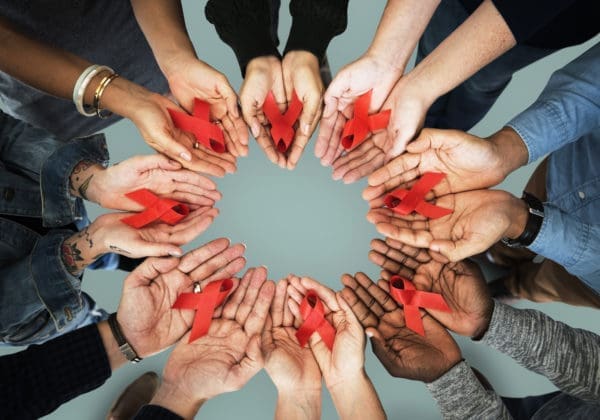December 1st is World AIDS Day, a day dedicated to unity and support for the estimated 36.7 million people living with HIV. Since the virus was first identified in 1984, major advances have been made in detection, prevention, treatment and awareness, In fact, new HIV infections have been reduced by 47% since the peak of the virus in 1996. Last year, there were roughly 1.8 million new infections compared to approximately 3.4 million in 1996. But the virus is still a major threat. World AIDS Day is a crucial initiative, as it serves as global reminder that the virus remains a major health concern.
Sadly, many people still don’t fully understand the facts about AIDS and HIV, including how to properly protect themselves from contracting the virus. For people living with HIV, they have to endure not only the chronic pain and psychological toll of the virus, but also with the societal stigmas and discrimination.
While significant strides have been made, the belief behind World AIDS Day is that there is still an urgent need to “remind the public and government that HIV has not gone away” and “to raise money, increase awareness, fight prejudice and improve education.”
HIV and AIDS are not the same
The terms are often used interchangeably, but HIV and AIDS are not the same thing. AIDS stands for Acquired Immune Deficiency Syndrome. HIV stands for Human Immunodeficiency Virus. People cannot have AIDS without first being infected with HIV. With proper diagnosis and treatment, people who have HIV do not necessarily develop AIDS. They may not even develop the painful symptoms of HIV infection.
AIDS is a stage of HIV
There are various stages of the HIV virus. If it reaches advanced stages where the body’s immune system has been badly compromised, then the term AIDS is used to define that stage of infection. It is the most severe stage of HIV. Those who are diagnosed with HIV “are diagnosed with AIDS if they have a CD4 count of less than 200 cells/mm3 or if they have certain opportunistic infections. Without treatment, people with AIDS typically survive about 3 years.”
The body’s CD4 T-cells are considered “helper” cells. They work with the immune system to fight off infections by triggering the body’s natural defenses. In HIV, the virus actually attacks its own healthy CD4 cells and kills them, leaving the body vulnerable to illnesses and infection. Many of these would not be life-threatening to a person with a healthy CD4 count (500-1,500), but for a person with AIDS (less than 200), they can be deadly.
Educating the public to save lives
Promoting awareness about AIDS and HIV globally is a critical step in reducing the stigma associated with them. The public’s lack of understanding about how the virus was transmitted created a blanket of fear and confusion that in many ways still exists 34 years later. This hope for fighting prejudices and improving education is at the core of World AIDS Day.
In 1985 at the height of the AIDS epidemic, 3 year old Eve Van Grafhorst was one of the first-ever children who contracted HIV. She got the virus through a blood transfusion she received at birth. Eve’s older sister, Dana Lee, recently discussed her sister and the public’s reaction to the diagnosis. The family was “shunned, and even forced into hiding, before eventually being hounded from the country.” Dana noted that the “neighbors had built a six-foot fence to keep us out, or to keep the AIDS out, I guess” and that no one in her community had ever reached out to apologize for their behavior.
Eve succumbed to the virus at the age of 11. But her story, which is now 25 years old, touched lives and the struggles she endured inspired others around the world to take action to promote awareness and improve the lives of people living with HIV.
Managing chronic pain from HIV/AIDS
Various studies report that people living with HIV also live with chronic pain and that it often interferes with daily life. The pain can stem the infection itself, which causes inflammation and nerve damage. Pain is also believed to be a common side effect from HIV treatment. More interestingly, the stigma associated with HIV can play a role in triggering chronic pain.
In one study, researchers tested the role that psychological factors like stigma play in relation to chronic pain symptoms. They found it to be connected to “depression and anxiety symptoms, more HIV-related symptoms, and poorer antiviral medication adherence.”
Living with pain associated with HIV
Since HIV is an autoimmune disease, the body is constantly firing immune responses in an effort to stave off infections or foreign antibodies. When the immune system is essentially fighting itself, it can cause all sorts of aches and pains throughout the body from dull, achy pain to intense pain that requires a pain management plan.
For example, a common chronic pain condition for people living with HIV is arthritis. This causes joints and surrounding tissue to get hot and swollen and can be treated with non-steroidal drugs or steroids such as prednisone. In other instances, people living with HIV can experience reactive arthritis, which can be more painful. It can cause the fingers and toes to swell and the arch of the foot to become inflamed.
Unfortunately for people living with HIV, the list of painful conditions and illnesses associated with the HIV is long. It’s important for patients to be forthcoming about their pain so their healthcare teams can create effective and safe pain management plans.
“Sometimes [painful conditions] are simply considered trivial complaints by a patient or by a physician who feels that the stabilization of HIV by combination therapy is such a godsend that it is inappropriate to complain about sore muscles and aching joints, according to Dr. Dan Bowers, a physician devoted to HIV care. “This dismissal is not acceptable.”
Improving detection & prevention
If an otherwise healthy person is infected with HIV and immediately begins antiretroviral therapy, he can decrease his risk of getting a serious illness and hope to live a typical life expectancy.
In contrast, the majority of patients who reach the advanced stages of HIV, are diagnosed with AIDS and do not receive antiretroviral therapy do not live beyond 2 years. That’s why detection and prevention is so critically important.
Show your support on World AIDS Day.
Get your red ribbon to wear in person or display online.
Know your HIV status.
Click here to learn how to get tested.
Assess your HIV-related pain.
Learn more here.
How will you show support for people living with HIV on World AIDS Day?
Let us know in the comments section.
What topics related to managing HIV pain would you like to see us research?
Email us at info@painresource.com with your ideas!
Are you on Facebook?
Join our online community by clicking here.




